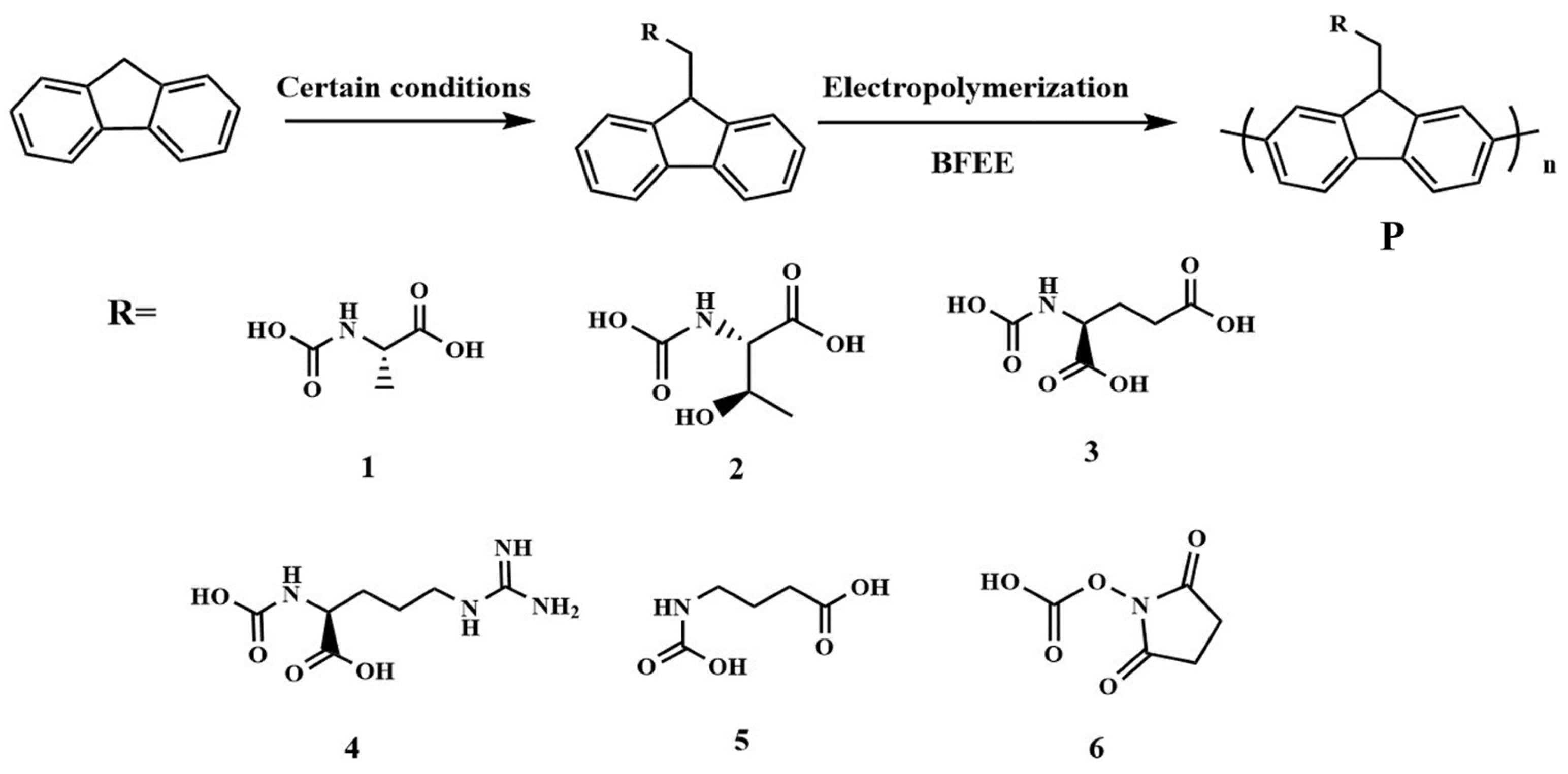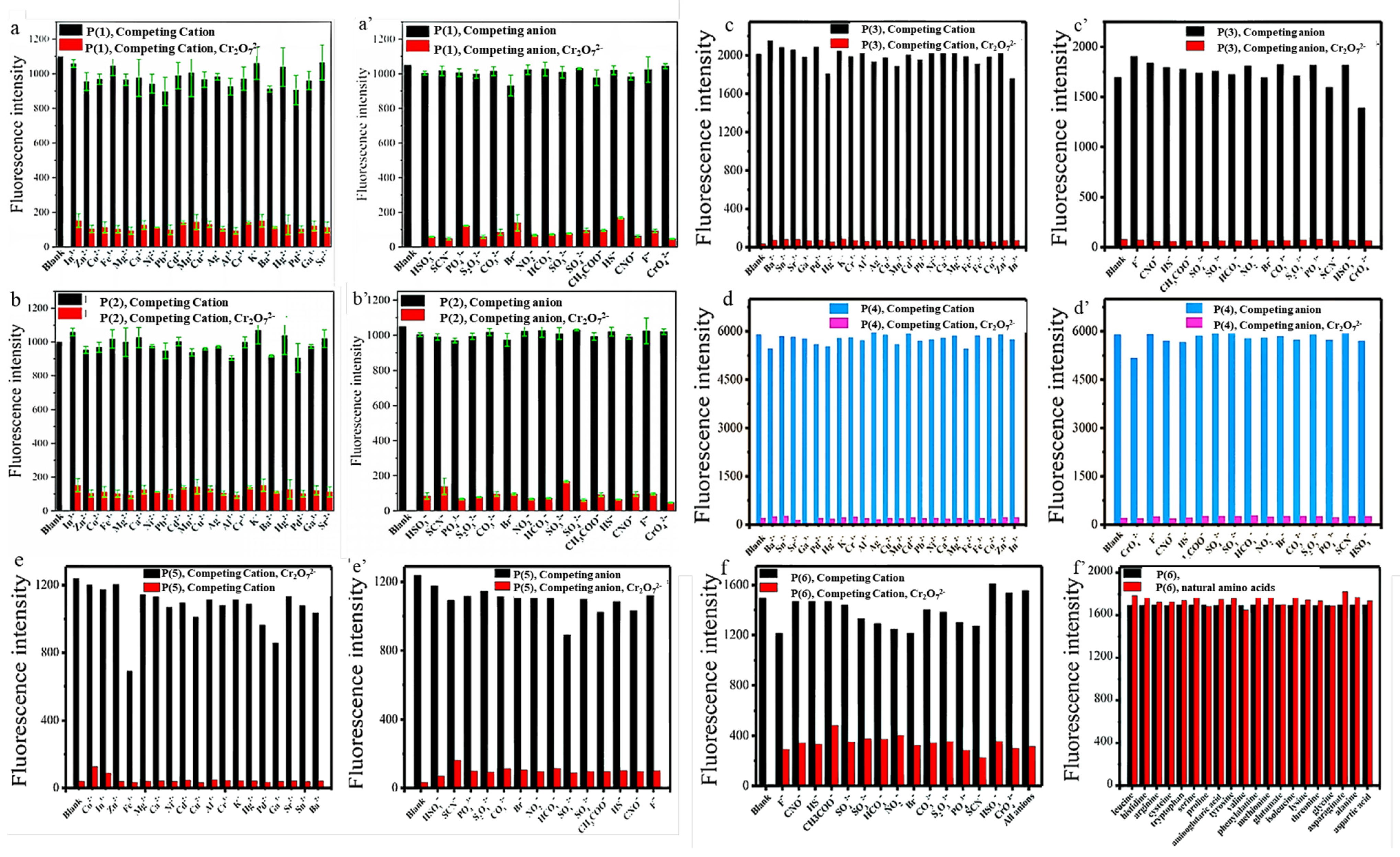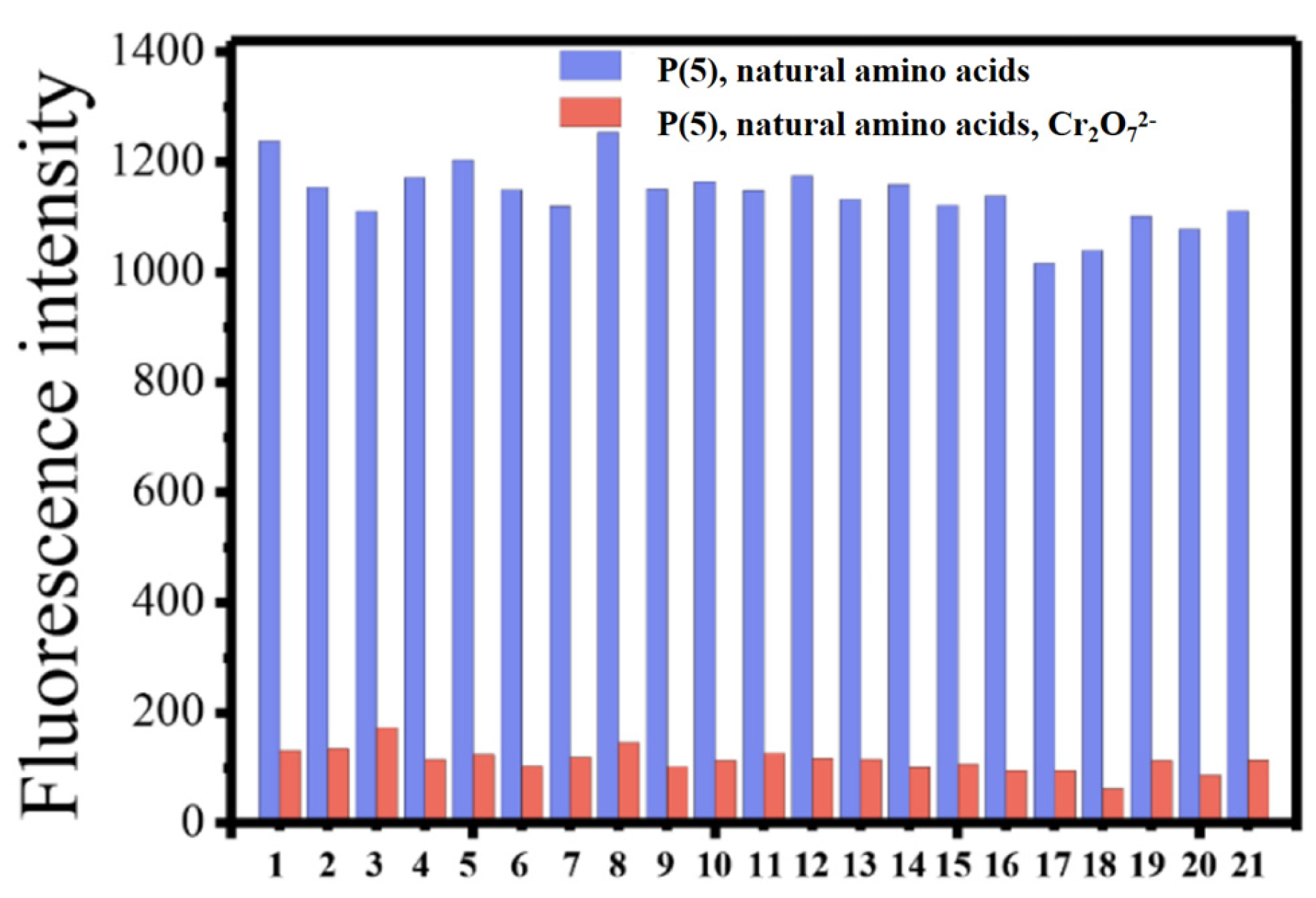Amino Acid-Functionalized Polyfluorenes: A Class of Ultra-Sensitive Fluorescent Sensors Favoring Cr2O72− †
Abstract
:1. Introduction
2. Materials and Methods
3. Results and Discussion
3.1. Selectivity of Polyfluorene Derivatives towards Cr2O72−
3.2. Sensitivity Test of Fluorene and Polyfluorene Derivatives towards Cr2O72−
4. Conclusions
Author Contributions
Funding
Institutional Review Board Statement
Informed Consent Statement
Data Availability Statement
Conflicts of Interest
References
- Kapoor, R.T.; Mfarrej, M.F.B.; Alam, P.; Rinklebe, J.; Ahmad, P. Accumulation of chromium in plants and its repercussion in animals and humans. Environ. Pollut. 2022, 301, 119044. [Google Scholar] [CrossRef] [PubMed]
- Li, F.; Duan, X.; Li, H.; Zou, L.; Liu, G.; Liu, F.; Zhang, G.; Xu, J. Dual effect of aminobutyric acid group and “molecular wire effect” of conjugated polymer enables ultra-trace detection of Cr2O72− in fruits. Microchem. J. 2022, 178, 107426. [Google Scholar] [CrossRef]
- Li, F.; Duan, X.; Hu, S.; Zhang, L.; Shen, L.; Liu, F.; Li, H.; Zhang, G.; Xu, J. Ultra-sensitive detection of Cr2O72− in farmland achieved by an electrosynthesized fluorescent poly (Fmoc-succinimide). Dyes Pigment. 2021, 193, 109568. [Google Scholar] [CrossRef]
- Li, C.; Numata, M.; Takeuchi, M.; Shinkai, S. A sensitive colorimetric and fluorescent probe based on a polythiophene derivative for the detection of ATP. Angew. Chem. Int. Ed. 2005, 44, 6371–6374. [Google Scholar] [CrossRef] [PubMed]
- Lim, J.W.; Kim, T.Y.; Woo, M.A. Trends in sensor development toward next-generation point-of-care testing for mercury. Biosens. Bioelectron. 2021, 183, 113228. [Google Scholar] [CrossRef] [PubMed]
- Cheng, W.; Wu, X.; Zhang, Y.; Wu, D.; Meng, L.; Chen, Y.; Tang, X. Recent applications of hydrogels in food safety sensing: Role of hydrogels. Trends Food Sci. Tech. 2022, 129, 244–257. [Google Scholar] [CrossRef]
- Li, R.; Liang, F.; Hu, X.; Bian, H.; Deng, C.; Seidi, F.; Liu, Y. A versatile cellulose nanocrystal-carbon dots architecture: Preparation and environmental/biological applications. Carbohyd. Polym. 2022, 298, 120073. [Google Scholar] [CrossRef] [PubMed]
- Dwivedi, A.K.; Prasad, K.M.; Trivedi, V.; Iyer, P.K. Interaction of heme proteins with anionic polyfluorene: Insights into physiological effects, folding events, and inhibition activity. ACS Appl. Mater. Interfaces 2012, 4, 6371–6377. [Google Scholar] [CrossRef] [PubMed]
- Dwivedi, A.K.; Saikia, G.; Iyer, P.K. Aqueous polyfluorene probe for the detection and estimation of Fe3+ and inorganic phosphate in blood serum. J. Mater. Chem. 2011, 21, 2502–2507. [Google Scholar] [CrossRef]
- Li, F.; Zhang, G.; Zou, L.; Zhang, X.; Liu, F.; Li, H.; Xu, J.; Duan, X. Amino acid groups enable electrosynthesized polyfluorenes to specifically recognize Cr2O72−. ACS Appl. Polym. Mater. 2022, 4, 815–821. [Google Scholar] [CrossRef]
- Li, H.; Li, F.; Liu, F.; Chen, X.; Xu, W.; Shen, L.; Xu, J.; Yang, R.; Zhang, G. High-quality conjugated polymers achieving ultra-trace detection of Cr2O72− in agricultural products. Molecules 2022, 27, 4294. [Google Scholar] [CrossRef] [PubMed]



| Monomers | 1 | 2 | 3 | 4 | 5 | 6 |
|---|---|---|---|---|---|---|
| LOD | 0.11 nM | 0.27 nM | 3.3 μM | 16.6 μM | 1.67 μM | 83.3 μM |
| Polymers | P1 | P2 | P3 | P4 | P5 | P6 |
| LOD | 1.98 fM | 3.72 fM | 16.67 pM | 3.33 μM | 16.6 fM | 8.3 fM |
Disclaimer/Publisher’s Note: The statements, opinions and data contained in all publications are solely those of the individual author(s) and contributor(s) and not of MDPI and/or the editor(s). MDPI and/or the editor(s) disclaim responsibility for any injury to people or property resulting from any ideas, methods, instructions or products referred to in the content. |
© 2023 by the authors. Licensee MDPI, Basel, Switzerland. This article is an open access article distributed under the terms and conditions of the Creative Commons Attribution (CC BY) license (https://creativecommons.org/licenses/by/4.0/).
Share and Cite
Zhang, W.; Li, H.; Li, Y.; Cao, L.; Sheng, L.; Zhang, G.; Chen, S. Amino Acid-Functionalized Polyfluorenes: A Class of Ultra-Sensitive Fluorescent Sensors Favoring Cr2O72− . Eng. Proc. 2023, 48, 52. https://doi.org/10.3390/CSAC2023-14909
Zhang W, Li H, Li Y, Cao L, Sheng L, Zhang G, Chen S. Amino Acid-Functionalized Polyfluorenes: A Class of Ultra-Sensitive Fluorescent Sensors Favoring Cr2O72− . Engineering Proceedings. 2023; 48(1):52. https://doi.org/10.3390/CSAC2023-14909
Chicago/Turabian StyleZhang, Wanyi, Hui Li, Yu Li, Lei Cao, Li Sheng, Ge Zhang, and Shuai Chen. 2023. "Amino Acid-Functionalized Polyfluorenes: A Class of Ultra-Sensitive Fluorescent Sensors Favoring Cr2O72− " Engineering Proceedings 48, no. 1: 52. https://doi.org/10.3390/CSAC2023-14909
APA StyleZhang, W., Li, H., Li, Y., Cao, L., Sheng, L., Zhang, G., & Chen, S. (2023). Amino Acid-Functionalized Polyfluorenes: A Class of Ultra-Sensitive Fluorescent Sensors Favoring Cr2O72− . Engineering Proceedings, 48(1), 52. https://doi.org/10.3390/CSAC2023-14909







